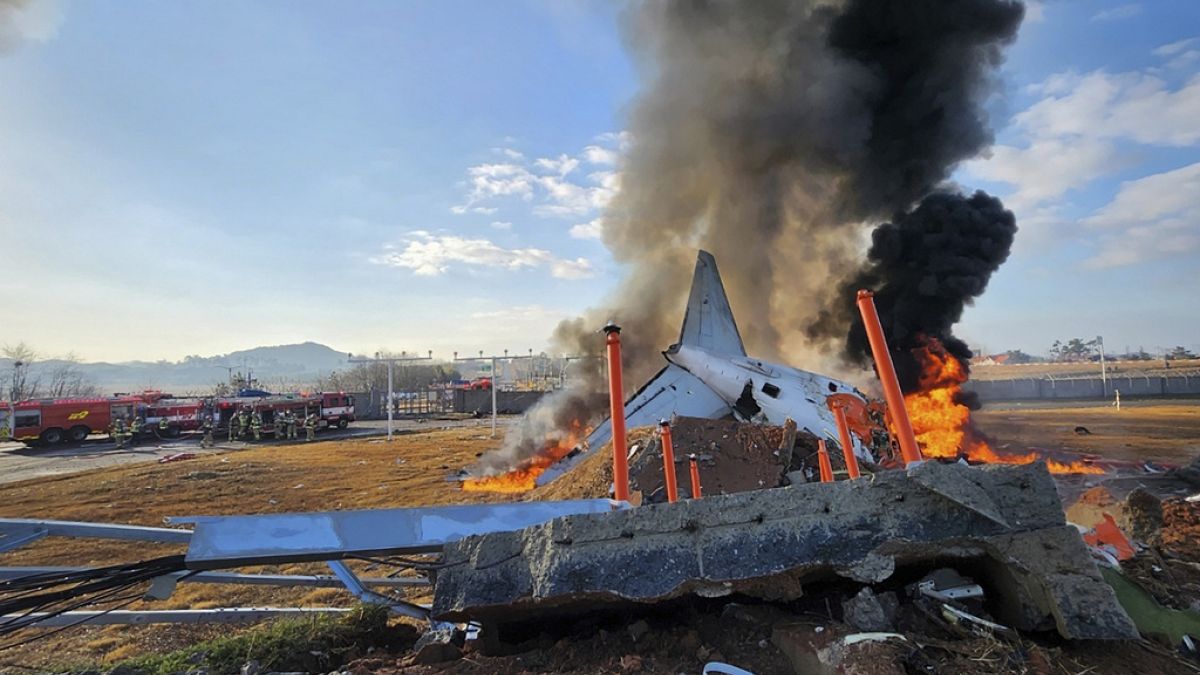The Jeju Air plane from Bangkok attempted a belly landing at Muan International Airport after its landing gear reportedly failed to deploy.
The passenger plane burst into flames on Sunday at nine in the morning after it skidded off the runway and slammed into a concrete fence when its front landing gear apparently failed to deploy.
All but two of the 181 people on board died in what was one of the country’s worst aviation disasters, the South Korean fire agency said. Four of the dead were crew members, the rest passengers.
Emergency workers pulled two people, both crew members, to safety. Health officials said they are conscious and not in life-threatening condition.
The Jeju Air passenger plane crashed while landing in the town of Muan, about 290 kilometres south of the capital Seoul. The Transport Ministry said the plane was a 15-year-old Boeing 737-800 jet that was returning from Bangkok.
The fire agency deployed 32 fire trucks and several helicopters to contain the blaze. About 1,560 firefighters, police officers, soldiers and other officials were also sent to the site, it said.
Footage of the crash aired by South Korean television channels showed the Jeju Air plane skidding across the airstrip at high speed, apparently with its landing gear still closed, overrunning the runway and colliding head-on with a concrete wall on the outskirts of the facility, triggering an explosion. Other local TV stations aired footage showing thick plumes of black smoke billowing from the plane, which was engulfed in flames.
Lee Jeong-hyeon, chief of the Muan fire station, told a televised briefing that the plane was completely destroyed, with only the tail assembly remaining recognizable among the wreckage. Lee said that workers were looking into various possibilities about what caused the crash, including whether the aircraft was struck by birds, Lee said.
Transport Ministry officials later said their early assessment of communication records show the airport control tower issued a bird strike warning to the plane shortly before it intended to land and gave its pilot permission to land in a different area. The pilot sent out a distress signal shortly before the plane went past the runway and skidded across a buffer zone before hitting the wall, the officials said.
Senior Transport Ministry official Joo Jong-wan said workers have retrieved the flight data and cockpit voice recorders of the plane’s black box, which will be examined by government experts investigating the cause of the crash and fire. Joo said the runway at the Muan airport will be closed until Jan. 1.
The Transport Ministry said the plane’s passengers include two Thai nationals. Thailand’s prime minister, Paetongtarn Shinawatra, expressed deep condolences to the families of those affected by the accident in a post on social platform X. Paetongtarn said she ordered the Ministry of Foreign Affairs to provide assistance immediately.
Kerati Kijmanawat, the director of Airports of Thailand, confirmed in a statement that Jeju Air flight 7C 2216 departed from Suvarnabhumi Airport with no reports of abnormal conditions with the aircraft or on the runway.
Jeju Air in a statement expressed its “deep apology” over the crash and said it will do its “utmost to manage the aftermath of the accident.”
In a televised news conference, Kim E-bae, Jeju Air’s president, bowed deeply with other senior company officials as he apologized to bereaved families and said he feels “full responsibility” for the incident. Kim said the company hadn’t identified any mechanical problems with the aircraft following regular checkups and that he would wait for the results of government investigations into the cause of the incident.
Family members wailed as officials announced the names of some victims at a lounge in the Muan airport.
Boeing said in a statement on X it was in contact with Jeju Air and is ready to support the company in dealing with the crash.
“We extend our deepest condolences to the families who lost loved ones, and our thoughts remain with the passengers and crew,” Boeing said.
It’s one of the deadliest disasters in South Korea’s aviation history. The last time South Korea suffered a large-scale air disaster was in 1997, when a Korean Airline plane crashed in Guam, killing 228 people on board. In 2013, an Asiana Airlines plane crash-landed in San Francisco, killing three and injuring approximately 200.
Read the full article here
